Physics Experiment: Determining Gravitational Acceleration 'g'
VerifiedAdded on 2023/06/11
|11
|2561
|328
Practical Assignment
AI Summary
This assignment presents a laboratory experiment focused on determining the acceleration due to gravity (g) using the free fall method. The experiment involves dropping an object from various heights and measuring the time it takes to reach the ground, with initial velocity considered zero. Two methods, graphical and formula-based, are employed to calculate 'g'. The experiment aims to verify the theoretical value of 'g' (9.8 m/s²) and analyze potential errors. The methodology includes detailed steps for data collection, and the results are analyzed using both a graph of height vs. half the square of time and direct calculation. The analysis discusses potential systematic errors and compares the experimental 'g' value with the accepted value, highlighting the accuracy and limitations of each method. The graphical method yields a value closer to the accepted 'g', while the formula method exhibits a higher percentage of error, likely due to measurement inaccuracies.

P a g e | 1
Name:
Course:
Tutor:
Date:
Name:
Course:
Tutor:
Date:
Paraphrase This Document
Need a fresh take? Get an instant paraphrase of this document with our AI Paraphraser

P a g e | 2
Determination of g by free fall
Abstract
The laws of gravity are applied in the measurement of g through the free fall method. The
dynamics of the free fall can be analyzed through a lab session. An object can be released from a
certain height where the initial velocity is considered to be zero. The formula ∆s = v0t + ½ at2 is
important when understanding the relation of gravitational acceleration in respect with time and
height. The graphical method and formula method are two important methods which can be used
to determine the g through free fall means.
Determination of g by free fall
Abstract
The laws of gravity are applied in the measurement of g through the free fall method. The
dynamics of the free fall can be analyzed through a lab session. An object can be released from a
certain height where the initial velocity is considered to be zero. The formula ∆s = v0t + ½ at2 is
important when understanding the relation of gravitational acceleration in respect with time and
height. The graphical method and formula method are two important methods which can be used
to determine the g through free fall means.
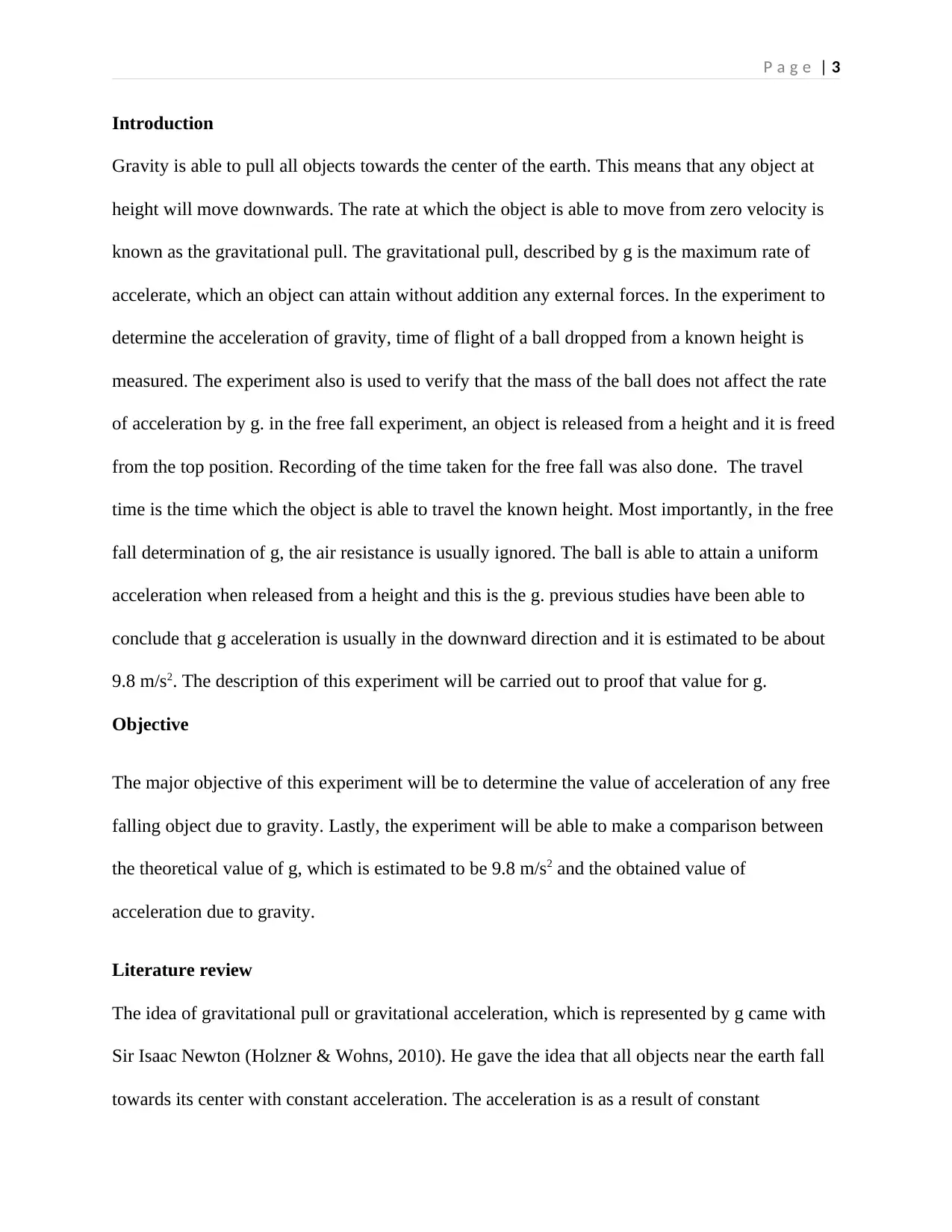
P a g e | 3
Introduction
Gravity is able to pull all objects towards the center of the earth. This means that any object at
height will move downwards. The rate at which the object is able to move from zero velocity is
known as the gravitational pull. The gravitational pull, described by g is the maximum rate of
accelerate, which an object can attain without addition any external forces. In the experiment to
determine the acceleration of gravity, time of flight of a ball dropped from a known height is
measured. The experiment also is used to verify that the mass of the ball does not affect the rate
of acceleration by g. in the free fall experiment, an object is released from a height and it is freed
from the top position. Recording of the time taken for the free fall was also done. The travel
time is the time which the object is able to travel the known height. Most importantly, in the free
fall determination of g, the air resistance is usually ignored. The ball is able to attain a uniform
acceleration when released from a height and this is the g. previous studies have been able to
conclude that g acceleration is usually in the downward direction and it is estimated to be about
9.8 m/s2. The description of this experiment will be carried out to proof that value for g.
Objective
The major objective of this experiment will be to determine the value of acceleration of any free
falling object due to gravity. Lastly, the experiment will be able to make a comparison between
the theoretical value of g, which is estimated to be 9.8 m/s2 and the obtained value of
acceleration due to gravity.
Literature review
The idea of gravitational pull or gravitational acceleration, which is represented by g came with
Sir Isaac Newton (Holzner & Wohns, 2010). He gave the idea that all objects near the earth fall
towards its center with constant acceleration. The acceleration is as a result of constant
Introduction
Gravity is able to pull all objects towards the center of the earth. This means that any object at
height will move downwards. The rate at which the object is able to move from zero velocity is
known as the gravitational pull. The gravitational pull, described by g is the maximum rate of
accelerate, which an object can attain without addition any external forces. In the experiment to
determine the acceleration of gravity, time of flight of a ball dropped from a known height is
measured. The experiment also is used to verify that the mass of the ball does not affect the rate
of acceleration by g. in the free fall experiment, an object is released from a height and it is freed
from the top position. Recording of the time taken for the free fall was also done. The travel
time is the time which the object is able to travel the known height. Most importantly, in the free
fall determination of g, the air resistance is usually ignored. The ball is able to attain a uniform
acceleration when released from a height and this is the g. previous studies have been able to
conclude that g acceleration is usually in the downward direction and it is estimated to be about
9.8 m/s2. The description of this experiment will be carried out to proof that value for g.
Objective
The major objective of this experiment will be to determine the value of acceleration of any free
falling object due to gravity. Lastly, the experiment will be able to make a comparison between
the theoretical value of g, which is estimated to be 9.8 m/s2 and the obtained value of
acceleration due to gravity.
Literature review
The idea of gravitational pull or gravitational acceleration, which is represented by g came with
Sir Isaac Newton (Holzner & Wohns, 2010). He gave the idea that all objects near the earth fall
towards its center with constant acceleration. The acceleration is as a result of constant
⊘ This is a preview!⊘
Do you want full access?
Subscribe today to unlock all pages.

Trusted by 1+ million students worldwide

P a g e | 4
gravitational pull and attraction towards the center (Tillery, Slater & Slater, 2017). When an
object is dropped from an initial velocity of zero near the earth’s surface, the pull makes it to
accelerate. This is usually a constant accelerate which is due to the gravity (g) pull. For the
analysis, the motion of free falling objects is known to be one dimensional and they have
constant acceleration, which is the g. Generally, the object starts off from an initial velocity of
Vo, which is zero (Chen & Cook, 2013). The acceleration due to gravity a is constant and this
means that the object will obey the following kinematics;
∆s = v0t + ½ at2
Whereby;
s = height of the fall in meters
u = the initial velocity in ms-1
v = the final velocity in ms-1
a = the acceleration due to gravity, also represented as g ms-2
t = time taken for free fall in seconds
As noted earlier, the initial velocity is taken as zero. This means that the value of v0t turns out to
be zero. The ∆s is the change in height which the object is able to experience in respect to time t.
“Any object, which is moving, and being acted upon only be the force of gravity is said to be "in
a state of free fall" (Hilsen, Page & Physics Curriculum & Instruction (Firm), 2012)”. The
definition isa able to bring out two importrant aspects of the free falling objects which include:
gravitational pull and attraction towards the center (Tillery, Slater & Slater, 2017). When an
object is dropped from an initial velocity of zero near the earth’s surface, the pull makes it to
accelerate. This is usually a constant accelerate which is due to the gravity (g) pull. For the
analysis, the motion of free falling objects is known to be one dimensional and they have
constant acceleration, which is the g. Generally, the object starts off from an initial velocity of
Vo, which is zero (Chen & Cook, 2013). The acceleration due to gravity a is constant and this
means that the object will obey the following kinematics;
∆s = v0t + ½ at2
Whereby;
s = height of the fall in meters
u = the initial velocity in ms-1
v = the final velocity in ms-1
a = the acceleration due to gravity, also represented as g ms-2
t = time taken for free fall in seconds
As noted earlier, the initial velocity is taken as zero. This means that the value of v0t turns out to
be zero. The ∆s is the change in height which the object is able to experience in respect to time t.
“Any object, which is moving, and being acted upon only be the force of gravity is said to be "in
a state of free fall" (Hilsen, Page & Physics Curriculum & Instruction (Firm), 2012)”. The
definition isa able to bring out two importrant aspects of the free falling objects which include:
Paraphrase This Document
Need a fresh take? Get an instant paraphrase of this document with our AI Paraphraser

P a g e | 5
The free falling object is free from the air resistance
When air resistance is not available, the objects moving near the free falling objects will
experience the same and uniform acceleration.
When the initial velocity is zero, the first equation reduces to;
Initial velocity =0 (ms-1) therefore,
s = 0t + ½ gt2
S = h = ½ gt2
Thus
g=2h/t2
Whereby;
g = the acceleration due to gravity in ms-2
h = vertical falling distance of object in m
t = time taken by the object to move the fall distance in seconds
The s in the equation can be replaced with h for the vertical height which the object falls. The
experiment of determining the g through free fall will be based on this second equation. The key
parameters which need to be measures are the time of travel or free fall of the object for the
given known distance (Matolyak, & Abū, 2014 ). The equation 2 will therefore be used to
determine the acceleration or g due to gravity or free fall. Therefore, the above equation is able
The free falling object is free from the air resistance
When air resistance is not available, the objects moving near the free falling objects will
experience the same and uniform acceleration.
When the initial velocity is zero, the first equation reduces to;
Initial velocity =0 (ms-1) therefore,
s = 0t + ½ gt2
S = h = ½ gt2
Thus
g=2h/t2
Whereby;
g = the acceleration due to gravity in ms-2
h = vertical falling distance of object in m
t = time taken by the object to move the fall distance in seconds
The s in the equation can be replaced with h for the vertical height which the object falls. The
experiment of determining the g through free fall will be based on this second equation. The key
parameters which need to be measures are the time of travel or free fall of the object for the
given known distance (Matolyak, & Abū, 2014 ). The equation 2 will therefore be used to
determine the acceleration or g due to gravity or free fall. Therefore, the above equation is able

P a g e | 6
to proof that the value of g can be found for free falling objects through measuring of free falls
time and knowing the height of falling.
Methodology
The use of the equations of motions is mostly applied when measuring the acceleration due to
gravity (g). When using this method, the object is usually dropped from a height6 and time taken
to cover the height is measured. The equation d = vi t + ½a t2 is applied to calculate the
acceleration due to gravity g.
Procedure
1) First, the object is placed at a height with an initial height of 0.7 meters. The distance to the
landing end is measured and recorded.
2) The object is then released from the height and the drop time is recorded. This step is repeated
for several times and calculation of average time is measured and recorded.
3) The same step 2 is repeated with different heights and the different fall times taken by the
objects are recorded for each drop.
4) The heights utilized in the experiment are between 1.0 meters to 1.7 meters, and their time
taken is recorded.
5) The value of g is then calculated for the different heights and time recorded for each fall.
6) Lastly, the final average value for all the values of g is then calculated. In addition, a plot of h
against 1/2t2 is also done as another method to find the value of gravitational acceleration g. after
getting the value of g, the deviation from the accepted value is calculated to find the difference
and deviation.
Table of results
Height (m) Ball time (s) 2h (m) 1/2t2 (s-2) Ball g value =
h/2t2 (m/s2)
to proof that the value of g can be found for free falling objects through measuring of free falls
time and knowing the height of falling.
Methodology
The use of the equations of motions is mostly applied when measuring the acceleration due to
gravity (g). When using this method, the object is usually dropped from a height6 and time taken
to cover the height is measured. The equation d = vi t + ½a t2 is applied to calculate the
acceleration due to gravity g.
Procedure
1) First, the object is placed at a height with an initial height of 0.7 meters. The distance to the
landing end is measured and recorded.
2) The object is then released from the height and the drop time is recorded. This step is repeated
for several times and calculation of average time is measured and recorded.
3) The same step 2 is repeated with different heights and the different fall times taken by the
objects are recorded for each drop.
4) The heights utilized in the experiment are between 1.0 meters to 1.7 meters, and their time
taken is recorded.
5) The value of g is then calculated for the different heights and time recorded for each fall.
6) Lastly, the final average value for all the values of g is then calculated. In addition, a plot of h
against 1/2t2 is also done as another method to find the value of gravitational acceleration g. after
getting the value of g, the deviation from the accepted value is calculated to find the difference
and deviation.
Table of results
Height (m) Ball time (s) 2h (m) 1/2t2 (s-2) Ball g value =
h/2t2 (m/s2)
⊘ This is a preview!⊘
Do you want full access?
Subscribe today to unlock all pages.

Trusted by 1+ million students worldwide
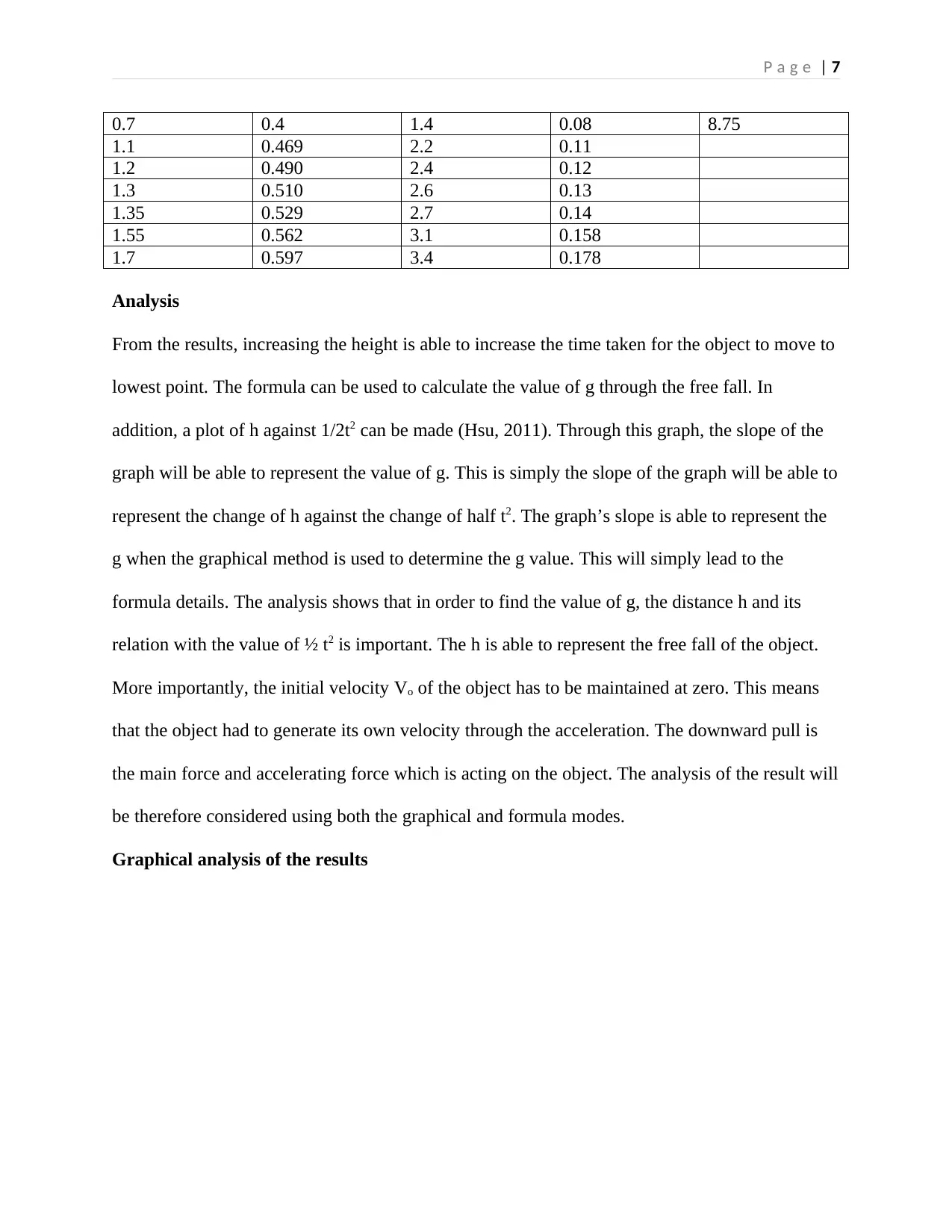
P a g e | 7
0.7 0.4 1.4 0.08 8.75
1.1 0.469 2.2 0.11
1.2 0.490 2.4 0.12
1.3 0.510 2.6 0.13
1.35 0.529 2.7 0.14
1.55 0.562 3.1 0.158
1.7 0.597 3.4 0.178
Analysis
From the results, increasing the height is able to increase the time taken for the object to move to
lowest point. The formula can be used to calculate the value of g through the free fall. In
addition, a plot of h against 1/2t2 can be made (Hsu, 2011). Through this graph, the slope of the
graph will be able to represent the value of g. This is simply the slope of the graph will be able to
represent the change of h against the change of half t2. The graph’s slope is able to represent the
g when the graphical method is used to determine the g value. This will simply lead to the
formula details. The analysis shows that in order to find the value of g, the distance h and its
relation with the value of ½ t2 is important. The h is able to represent the free fall of the object.
More importantly, the initial velocity Vo of the object has to be maintained at zero. This means
that the object had to generate its own velocity through the acceleration. The downward pull is
the main force and accelerating force which is acting on the object. The analysis of the result will
be therefore considered using both the graphical and formula modes.
Graphical analysis of the results
0.7 0.4 1.4 0.08 8.75
1.1 0.469 2.2 0.11
1.2 0.490 2.4 0.12
1.3 0.510 2.6 0.13
1.35 0.529 2.7 0.14
1.55 0.562 3.1 0.158
1.7 0.597 3.4 0.178
Analysis
From the results, increasing the height is able to increase the time taken for the object to move to
lowest point. The formula can be used to calculate the value of g through the free fall. In
addition, a plot of h against 1/2t2 can be made (Hsu, 2011). Through this graph, the slope of the
graph will be able to represent the value of g. This is simply the slope of the graph will be able to
represent the change of h against the change of half t2. The graph’s slope is able to represent the
g when the graphical method is used to determine the g value. This will simply lead to the
formula details. The analysis shows that in order to find the value of g, the distance h and its
relation with the value of ½ t2 is important. The h is able to represent the free fall of the object.
More importantly, the initial velocity Vo of the object has to be maintained at zero. This means
that the object had to generate its own velocity through the acceleration. The downward pull is
the main force and accelerating force which is acting on the object. The analysis of the result will
be therefore considered using both the graphical and formula modes.
Graphical analysis of the results
Paraphrase This Document
Need a fresh take? Get an instant paraphrase of this document with our AI Paraphraser

P a g e | 8
Figure 1: a graph of free fall height h against 1/2t2. Graph slope is able to represent the
value of g
From the above figure 1, the data from the experiment was plotted. The graphical representation
was done to give the best line of fit, in order to represent the linearly of the data obtained. The
slope of the graph is calculated and found to be 9.93± 0.08m/s2 which represent the g.
additionally, the y intercept is identified as 0.003+ 0.011m. The interception was assumed to be
zero from the initial calculation considering that the initial velocity and distance of the object
released was zero distance. The graphical representation of the value of interception as 0.003±
0.011 shows that there is some systematic error which will be translated to the final value of g as
well. The systematic error is found in the measurement of the value of height. The measurement
of the free fall distance is expected to be zero. Calculation of the error is important in order to
understand the systematic error. The error has to be found from the value of g from the
Figure 1: a graph of free fall height h against 1/2t2. Graph slope is able to represent the
value of g
From the above figure 1, the data from the experiment was plotted. The graphical representation
was done to give the best line of fit, in order to represent the linearly of the data obtained. The
slope of the graph is calculated and found to be 9.93± 0.08m/s2 which represent the g.
additionally, the y intercept is identified as 0.003+ 0.011m. The interception was assumed to be
zero from the initial calculation considering that the initial velocity and distance of the object
released was zero distance. The graphical representation of the value of interception as 0.003±
0.011 shows that there is some systematic error which will be translated to the final value of g as
well. The systematic error is found in the measurement of the value of height. The measurement
of the free fall distance is expected to be zero. Calculation of the error is important in order to
understand the systematic error. The error has to be found from the value of g from the
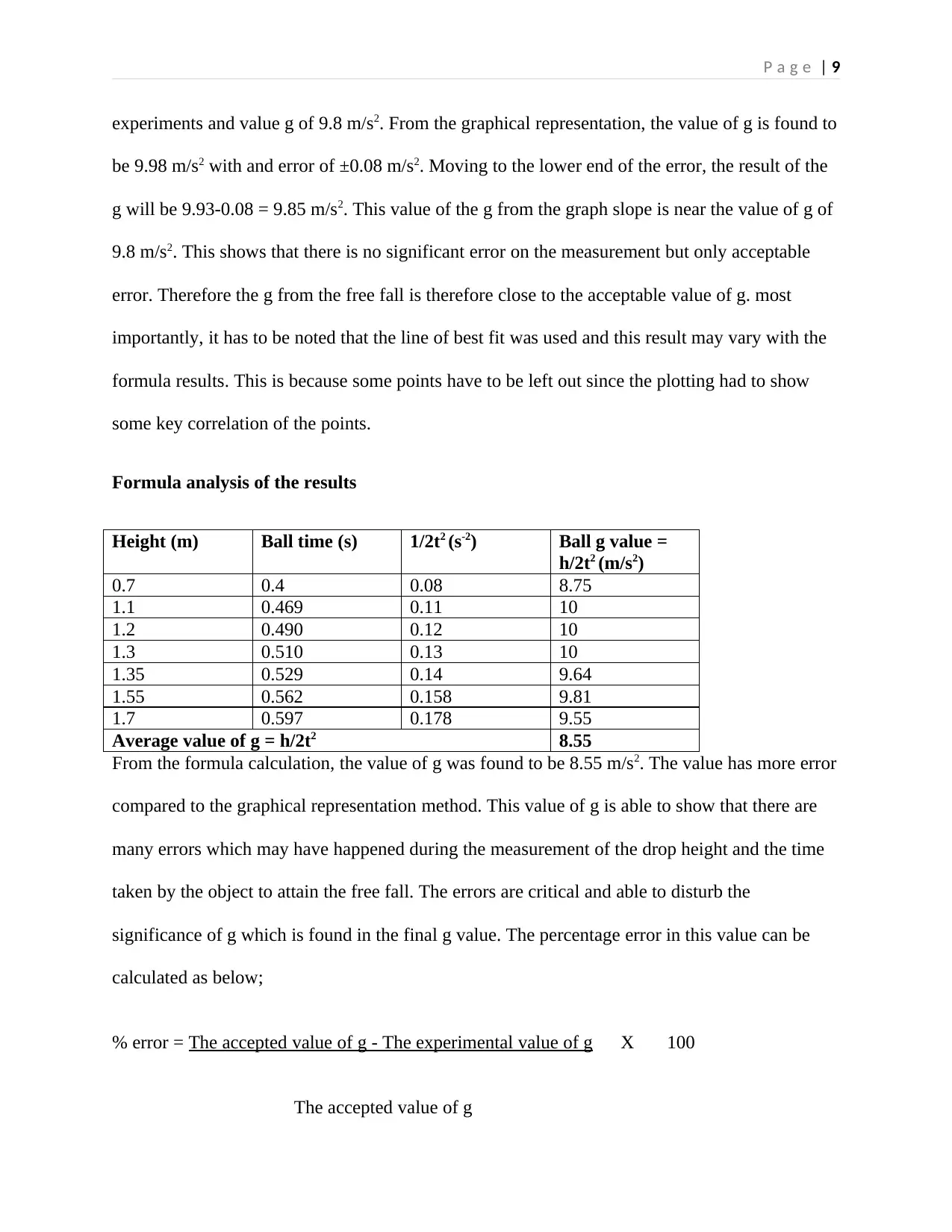
P a g e | 9
experiments and value g of 9.8 m/s2. From the graphical representation, the value of g is found to
be 9.98 m/s2 with and error of ±0.08 m/s2. Moving to the lower end of the error, the result of the
g will be 9.93-0.08 = 9.85 m/s2. This value of the g from the graph slope is near the value of g of
9.8 m/s2. This shows that there is no significant error on the measurement but only acceptable
error. Therefore the g from the free fall is therefore close to the acceptable value of g. most
importantly, it has to be noted that the line of best fit was used and this result may vary with the
formula results. This is because some points have to be left out since the plotting had to show
some key correlation of the points.
Formula analysis of the results
Height (m) Ball time (s) 1/2t2 (s-2) Ball g value =
h/2t2 (m/s2)
0.7 0.4 0.08 8.75
1.1 0.469 0.11 10
1.2 0.490 0.12 10
1.3 0.510 0.13 10
1.35 0.529 0.14 9.64
1.55 0.562 0.158 9.81
1.7 0.597 0.178 9.55
Average value of g = h/2t2 8.55
From the formula calculation, the value of g was found to be 8.55 m/s2. The value has more error
compared to the graphical representation method. This value of g is able to show that there are
many errors which may have happened during the measurement of the drop height and the time
taken by the object to attain the free fall. The errors are critical and able to disturb the
significance of g which is found in the final g value. The percentage error in this value can be
calculated as below;
% error = The accepted value of g - The experimental value of g X 100
The accepted value of g
experiments and value g of 9.8 m/s2. From the graphical representation, the value of g is found to
be 9.98 m/s2 with and error of ±0.08 m/s2. Moving to the lower end of the error, the result of the
g will be 9.93-0.08 = 9.85 m/s2. This value of the g from the graph slope is near the value of g of
9.8 m/s2. This shows that there is no significant error on the measurement but only acceptable
error. Therefore the g from the free fall is therefore close to the acceptable value of g. most
importantly, it has to be noted that the line of best fit was used and this result may vary with the
formula results. This is because some points have to be left out since the plotting had to show
some key correlation of the points.
Formula analysis of the results
Height (m) Ball time (s) 1/2t2 (s-2) Ball g value =
h/2t2 (m/s2)
0.7 0.4 0.08 8.75
1.1 0.469 0.11 10
1.2 0.490 0.12 10
1.3 0.510 0.13 10
1.35 0.529 0.14 9.64
1.55 0.562 0.158 9.81
1.7 0.597 0.178 9.55
Average value of g = h/2t2 8.55
From the formula calculation, the value of g was found to be 8.55 m/s2. The value has more error
compared to the graphical representation method. This value of g is able to show that there are
many errors which may have happened during the measurement of the drop height and the time
taken by the object to attain the free fall. The errors are critical and able to disturb the
significance of g which is found in the final g value. The percentage error in this value can be
calculated as below;
% error = The accepted value of g - The experimental value of g X 100
The accepted value of g
⊘ This is a preview!⊘
Do you want full access?
Subscribe today to unlock all pages.

Trusted by 1+ million students worldwide
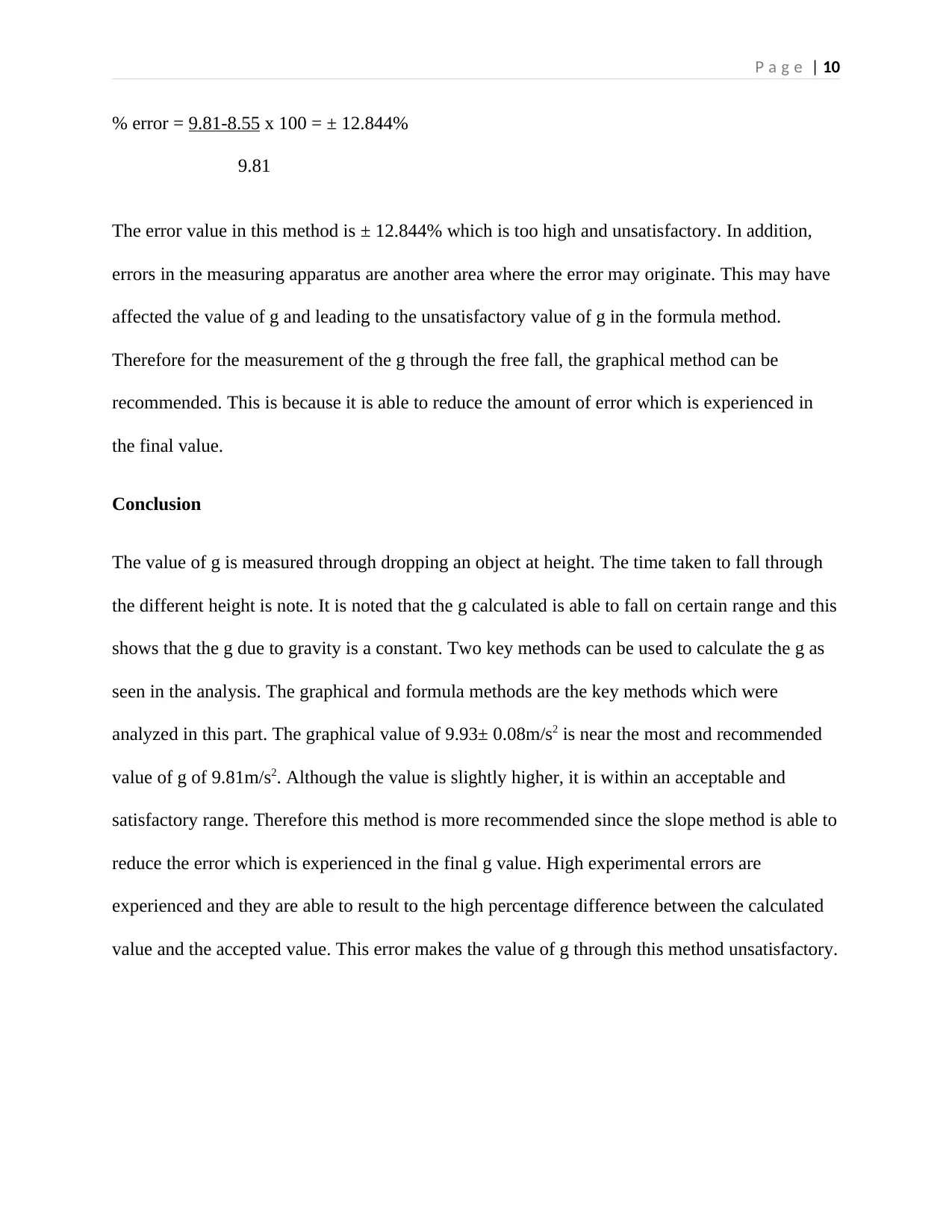
P a g e | 10
% error = 9.81-8.55 x 100 = ± 12.844%
9.81
The error value in this method is ± 12.844% which is too high and unsatisfactory. In addition,
errors in the measuring apparatus are another area where the error may originate. This may have
affected the value of g and leading to the unsatisfactory value of g in the formula method.
Therefore for the measurement of the g through the free fall, the graphical method can be
recommended. This is because it is able to reduce the amount of error which is experienced in
the final value.
Conclusion
The value of g is measured through dropping an object at height. The time taken to fall through
the different height is note. It is noted that the g calculated is able to fall on certain range and this
shows that the g due to gravity is a constant. Two key methods can be used to calculate the g as
seen in the analysis. The graphical and formula methods are the key methods which were
analyzed in this part. The graphical value of 9.93± 0.08m/s2 is near the most and recommended
value of g of 9.81m/s2. Although the value is slightly higher, it is within an acceptable and
satisfactory range. Therefore this method is more recommended since the slope method is able to
reduce the error which is experienced in the final g value. High experimental errors are
experienced and they are able to result to the high percentage difference between the calculated
value and the accepted value. This error makes the value of g through this method unsatisfactory.
% error = 9.81-8.55 x 100 = ± 12.844%
9.81
The error value in this method is ± 12.844% which is too high and unsatisfactory. In addition,
errors in the measuring apparatus are another area where the error may originate. This may have
affected the value of g and leading to the unsatisfactory value of g in the formula method.
Therefore for the measurement of the g through the free fall, the graphical method can be
recommended. This is because it is able to reduce the amount of error which is experienced in
the final value.
Conclusion
The value of g is measured through dropping an object at height. The time taken to fall through
the different height is note. It is noted that the g calculated is able to fall on certain range and this
shows that the g due to gravity is a constant. Two key methods can be used to calculate the g as
seen in the analysis. The graphical and formula methods are the key methods which were
analyzed in this part. The graphical value of 9.93± 0.08m/s2 is near the most and recommended
value of g of 9.81m/s2. Although the value is slightly higher, it is within an acceptable and
satisfactory range. Therefore this method is more recommended since the slope method is able to
reduce the error which is experienced in the final g value. High experimental errors are
experienced and they are able to result to the high percentage difference between the calculated
value and the accepted value. This error makes the value of g through this method unsatisfactory.
Paraphrase This Document
Need a fresh take? Get an instant paraphrase of this document with our AI Paraphraser
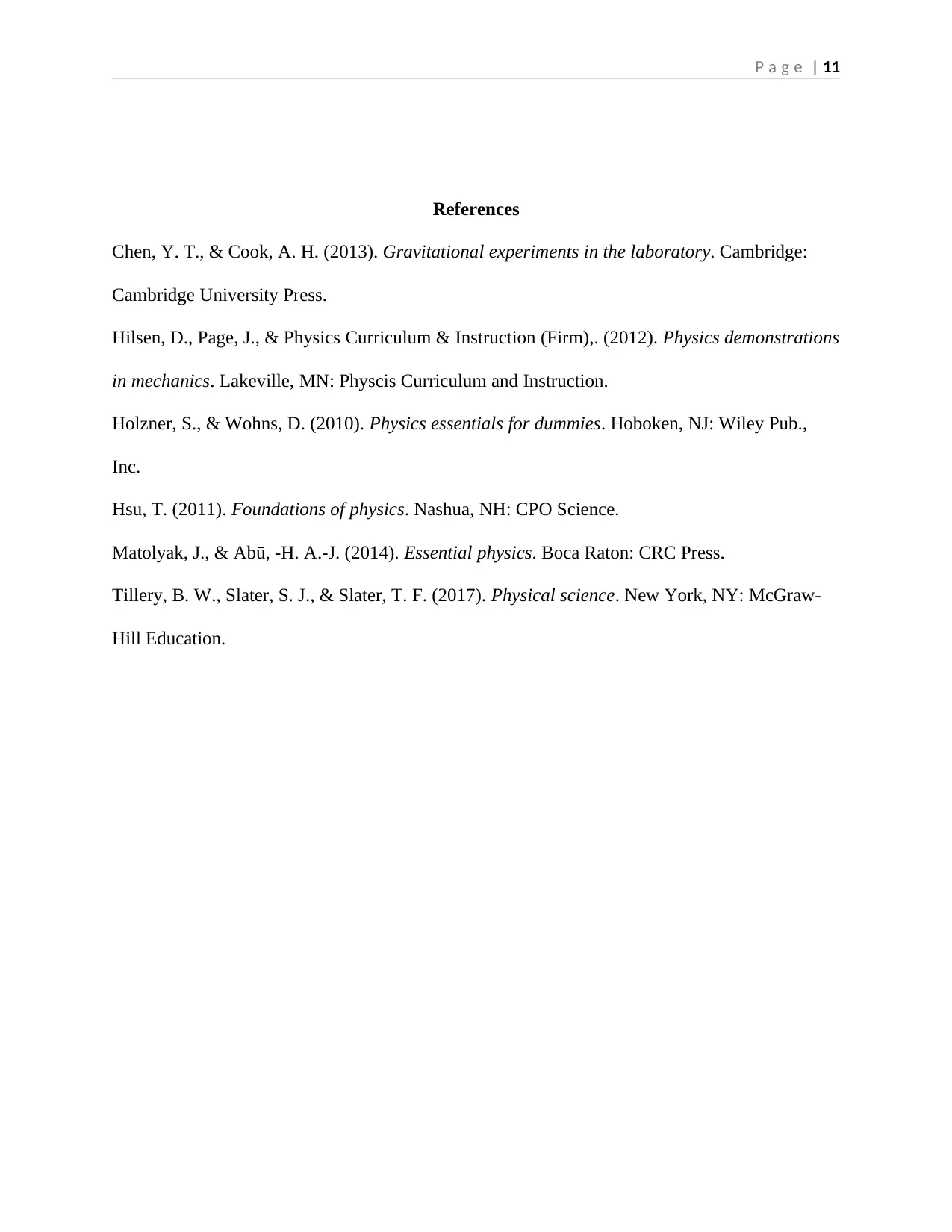
P a g e | 11
References
Chen, Y. T., & Cook, A. H. (2013). Gravitational experiments in the laboratory. Cambridge:
Cambridge University Press.
Hilsen, D., Page, J., & Physics Curriculum & Instruction (Firm),. (2012). Physics demonstrations
in mechanics. Lakeville, MN: Physcis Curriculum and Instruction.
Holzner, S., & Wohns, D. (2010). Physics essentials for dummies. Hoboken, NJ: Wiley Pub.,
Inc.
Hsu, T. (2011). Foundations of physics. Nashua, NH: CPO Science.
Matolyak, J., & Abū, -H. A.-J. (2014). Essential physics. Boca Raton: CRC Press.
Tillery, B. W., Slater, S. J., & Slater, T. F. (2017). Physical science. New York, NY: McGraw-
Hill Education.
References
Chen, Y. T., & Cook, A. H. (2013). Gravitational experiments in the laboratory. Cambridge:
Cambridge University Press.
Hilsen, D., Page, J., & Physics Curriculum & Instruction (Firm),. (2012). Physics demonstrations
in mechanics. Lakeville, MN: Physcis Curriculum and Instruction.
Holzner, S., & Wohns, D. (2010). Physics essentials for dummies. Hoboken, NJ: Wiley Pub.,
Inc.
Hsu, T. (2011). Foundations of physics. Nashua, NH: CPO Science.
Matolyak, J., & Abū, -H. A.-J. (2014). Essential physics. Boca Raton: CRC Press.
Tillery, B. W., Slater, S. J., & Slater, T. F. (2017). Physical science. New York, NY: McGraw-
Hill Education.
1 out of 11
Related Documents
Your All-in-One AI-Powered Toolkit for Academic Success.
+13062052269
info@desklib.com
Available 24*7 on WhatsApp / Email
![[object Object]](/_next/static/media/star-bottom.7253800d.svg)
Unlock your academic potential
Copyright © 2020–2025 A2Z Services. All Rights Reserved. Developed and managed by ZUCOL.





